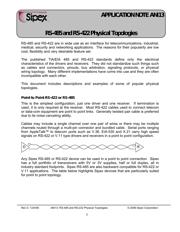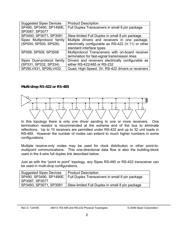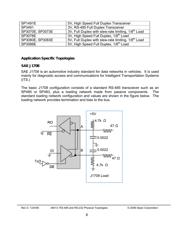herunterladen

Rev D 12/4/06 ANI13: RS-485 and RS-232 Physical Topologies © 2006 Sipex Corporation
1
RS-485 and RS-422 are in wide use as an interface for telecommunications, industrial,
medical, security and networking applications. The reasons for their popularity are low
cost, flexibility and very desirable feature set.
The published TIA/EIA 485 and RS-422 standards define only the electrical
characteristics of the drivers and receivers. They did not standardize such things such
as cables and connectors, pinouts, bus arbitration, signaling protocols, or physical
wiring topology. Many different implementations have come into use and they are often
incompatible with each other.
This document includes descriptions and examples of some of popular physical
topologies.
Point to Point RS-422 or RS-485
This is the simplest configuration, just one driver and one receiver. If termination is
used, it is only required at the receiver. Most RS-422 cables used to connect telecom
or data-com equipment are point to point links. Generally twisted pair cable is preferred
due to its noise canceling ability.
Cables may include a single channel over one pair of wires or there may be multiple
channels routed through a multi-pin connector and bundled cable. Serial ports ranging
from AppleTalk™ to telecom ports such as V.36, EIA-530 and X.21 carry high speed
signals on RS-422 or V.11 type drivers and receivers in a point to point configuration.
Any Sipex RS-485 or RS-422 device can be used in a point to point connection. Sipex
has a full portfolio of transceivers with 5V or 3V supplies, half or full duplex, all in
industry standard footprints. Sipex RS-485 are also backward compatible for RS-422 or
V.11 applications. The table below highlights Sipex devices that are particularly suited
for point to point topology.
D
R
Solved by
TM
APPLICATION NOTE ANI13
RS-485 and RS-422 Ph
y
sical To
p
olo
g
ies








